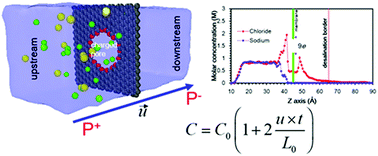Charged nanoporous graphene membranes for water desalination†
Abstract
Water desalination using positively and negatively charged single-layer nanoporous graphene membranes are investigated using molecular dynamics (MD) simulations. Pressure-driven flows are induced by the motion of specular reflection boundaries with a constant speed, resulting in a prescribed volumetric flow rate. Simulations are performed for 14.40 Å hydraulic pore diameter membrane with four different electric charges distributed on the pore edges. Salt rejection efficiencies and the resulting pressure drops are compared with the previously obtained base-line case of 9.9 Å diameter pristine nanoporous graphene membrane, which exhibits 100% salt rejection with 35.02 MPa pressure drop at the same flow rate. Among the positively charged cases, q = 9e shows 100% and 98% rejection for Na+ and Cl− ions respectively, with 35% lower pressure drop than the reference. For negatively charged pores, optimum rejection efficiencies of 94% and 93% are obtained for Na+ and Cl− ions for the q = −6e case, which requires 60.6% less pressure drop than the reference. The results indicate the high potential of using charged nanoporous graphene membranes in reverse osmosis (RO) desalination systems with enhanced performance.



 Please wait while we load your content...
Please wait while we load your content...